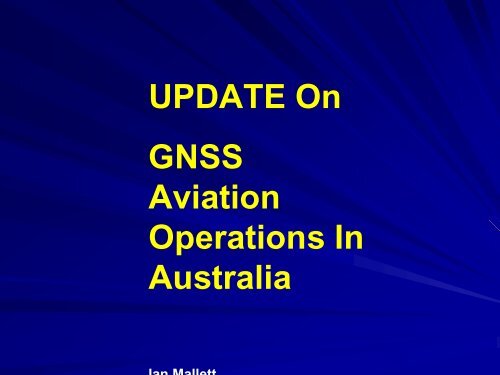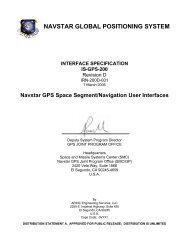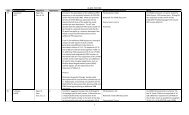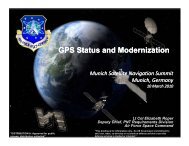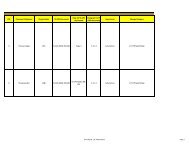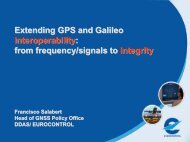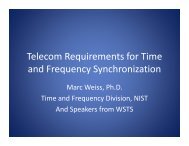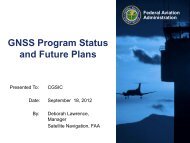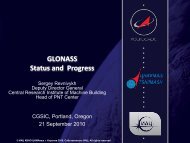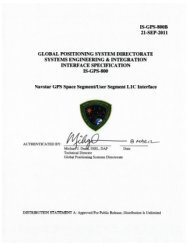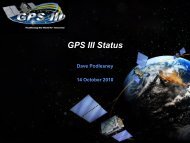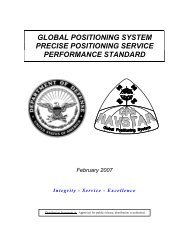View presentation (6 MB PDF) - GPS.gov
View presentation (6 MB PDF) - GPS.gov
View presentation (6 MB PDF) - GPS.gov
- No tags were found...
Create successful ePaper yourself
Turn your PDF publications into a flip-book with our unique Google optimized e-Paper software.
UPDATE OnGNSSAviationOperations InAustralia
<strong>GPS</strong>Excellent and improving service– Thank you USAF!!!Since 1995 no system issues– Primary Means <strong>GPS</strong> in 1995Issues– SPS – please update to real performance!– Some minor NANU ErrorsLeads to RAIM prediction errorsSome States still have concerns with <strong>GPS</strong>– Lack of Knowledge of ICAO (<strong>GPS</strong>) StatusMore education needed
BASIC GNSS OFFERSMANY BENEFITSStandards in PlaceCheap and simpleDisaster immuneLittle Implementation in RegionWhy?
Very high user expectations due to excellent performanceReduction to SPS level would totally undermine user confidence<strong>GPS</strong> Constellation Management Critical
BackgroundEarly decision – 1991– Lack of ground based infrastructure– Move to user pays funded systemNo Government support other than for regulationAcceptance of US TSO C129 receiverMove to GNSS navigation– 85% of all operations now use <strong>GPS</strong>– Approvals range from NVFR to RNP-AR
HISTORY 2ICAO GNSS Panel formed in 1994– ICAO Circular 267– Basis for ICAO GNSS Manual in 20032003 Navigation Systems Panel2003 ANC -11 = GNSS Transition OKICAO GNSS Manual - Doc 9849Doc 8071 – Flight Inspection & ValidationPBN Manual in 2007
GNSS Receivers
FIRST IFR <strong>GPS</strong> RECEIVERStill 10,000+ in operation
TSO C146 ReceiversIncludes VHF, VHF NAV and <strong>GPS</strong>Garmin Simulators - free download
TSO C145/6Fault Detection and Exclusion (FDE)Selective Availability OFFAdvanced RAI<strong>MB</strong>etter Interference ProtectionBetter Human FactorsSBAS Capable (but not required)Available Training Aids (CD)Primary Means Design
RECEIVER DESIGNSICAO – new approvals should beC145/6 basedMMRs – multi mode receivers– Now the GNSS Sensor in Modern AirlinersIATA – “No SBAS in our aircraft”– WHY???!!!!Galileo/<strong>GPS</strong> Hybrid Receivers expected
WAAS Satellite
GARMIN G1000
NEW AIRCRAFTTSO C146 Receivers– <strong>GPS</strong>– VOR– ILSNot fitted with ADF– Includes airlines aircraftRNAV “primary means’ approval– Needs the RPS for planning
GNSS ApprovalsPrimary Means Domestic Enroute – 1995<strong>GPS</strong> Arrivals - 1995<strong>GPS</strong> Oceanic - 1998<strong>GPS</strong> Non Precision Approaches – 1998<strong>GPS</strong> in Lieu of DME<strong>GPS</strong> Separation Standards<strong>GPS</strong> Safety HeightsFANS B747, Most Airline Aircraft (Defence??!!)
GNSS APPROVALS (2)RNP 0.1 NM into Queenstown– B737-80035 extra passengersGuided departuresADS-B B 2006– 5 NM Separation Standard ApprovedPrimary Means with TSO C145/6 receiver– Equivalent to VOR or NDBRAIM Predictions Systems– 1998 Airservices Australia system – Volpe US DoT– 2006 – with C145/6 and FDE
<strong>GPS</strong> ENROUTEApproved in 1995– Primary Means– Single TSO C129 ReceiverWith Baro-Aiding– Domestic FIR– 1% immediate fuel saving– Used by practically all IFR operators12 NM separation standard– 10 minutes of non RAIM ops allowed– No Enroute Prediction RequiredRNAV routes using <strong>GPS</strong>Savings around $50 mil per year in 1996No reported interference in 12 yearsNo Reported RAIM losses
RNAV (GNSS)APPROACHESApproved in 1998
272 Aerodromes500+ <strong>GPS</strong>approaches
<strong>GPS</strong> APPROACHESICAO Pans Ops– Based on US TERPSApproved in 1998– 500+ approaches– Used by GA and airlinesBoeing 737, A320, A330– “25” times safer than circling NPARAIM prediction system on web site<strong>GPS</strong> Training Material – videos, slides etc
Approach DesignInitialApproachWaypoint70°IntermediateApproachWaypointMissed ApproachTurning Point(if required)Initial ApproachWaypointInitial ApproachWaypoint5 nm70°5 nm 5 nmFinal ApproachWaypointMissedApproachPointMissedApproachHolding Point
RAIM PREDICTIONAvailable on Airservices Web Site– www.airservicesaustralia.com– Supplied to other countriesIs a NOTAMUses <strong>GPS</strong> Receiver plus Status MessagesMore accurate than receiverTwo types– C129 and C145/6 with FDE– Also oceanic predictionHighlighted errors in Status Messages
YSCBTSO-C129(a) (and equivalent) Fault Detection0703100409 TIL 07031004190703110405 TIL 0703110415<strong>GPS</strong> RAIM FD Unavbl for NPA TSO-C146a (and equivalent) Fault Detection OnlyNo <strong>GPS</strong> RAIM FD Outages for NPA TSO-C146a (and equivalent) Fault Detection andExclusion0703090749 TIL 07030907560703090824 TIL 07030908340703100409 TIL 07031004260703100438 TIL 07031004580703100741 TIL 07031008090703100816 TIL 07031008300703101609 TIL 07031016180703101625 TIL 07031016320703110405 TIL 07031104220703110434 TIL 0703110454<strong>GPS</strong> RAIM FDE Unavbl for NPA
INTERFERENCENo reported IFR interferenceInstallation Interference– 99%+ of all reportedTSO C145/6 receivers far better in testingDoD Trials– Need to be closely managed and monitoredJammers banned in AustraliaStrong Frequency Protection – ACAWill need isolation in busy environment
ACCIDENTSThree “RNAV (GNSS) Accidents”– Reports on www.atsb.<strong>gov</strong>.au– Two were ‘piloting’ errors– One unresolved – 11km offset in positionPossible Antenna Error???ATSB Survey of Pilot Attitudes to RNAV (GNSS)– Waypoint naming– Level of difficulty ‘second to NDB’Orientation, Step Down Fixes, Receiver Use– Value of APV Approaches
SUMMARYWGS-84 EssentialBasic GNSS provides high returns– Enroute RNAV– RNAV (GNSS) ApproachesAPV is ICAO preference– RNP APV is available now!Ensure ICAO RNP Manual is usedNew Approvals Should be based on TSO C145/6RNP +ADS-B B = Airspace Heaven!!!
B737-800
SafetyRNP BENEFITS– Runway aligned DA – almost anywhere– Lateral & vertical guided approaches– CFIT risks reduced– Use of automatics– Engine INOP solutionsOperations– Departure uplift+35 additional passengers!– Significantly Lower Minima (-1100’)(– Great cost benefit outcomeEfficiency – saves some 2-3002kg fuel per flightEnvironment – reduced noise footprint
The area under the fog is LakeWakatipu, which after the fogcleared looks like this..
Sydney GLS
GLS STATUSFAA have reverted to “R&D” status– Due design issues– FAA certification “early 2009”Aircraft OEMs – GLS Receivers certified– B737-800, A380 etc– No certified ground systemsQantas/Sydney <strong>GPS</strong> installation
A380 USED GLS INTO SYDNEY
ADS-B B inAustralia
Radar Like Application“ADS-B OUT”POSITION, ALTITUDE, IDENTITY(CALLSIGN),VELOCITY VECTOR, VERTICAL RATETypicallybroadcast 1/secondADS-B Ground station
UPPER AIRSPACE PROJECT28 ground stations are being deployed atexisting communications sites throughoutoutback Australia…expanding highlevel automatic airtraffic surveillancecapability from lessthan 20% of theAustraliancontinent to over99%.
FL300
ATLAS PROJECTMandate ADS-B B carriage– EOY 2013– Funding provided for GA installationMain benefits– Adoption of GNSS RNAV– No Replacement on enroute SSR RadarsNav Aid Rationalisation Program– Reduction in ADFs and VORs
APPROACHES WITHVERTICAL GUIDANCEAPV
ICAO APV DECISIONICAO CFIT Study – now RequiredUp to 8 times safer than circling NPAVertical Guidance is the Key!!ICAO 100% APV by 2016Adopted by APANPIRG in Regional PlanBooz Cost/Benefit Study– Baro-VNAV APV First
APV TECHNOLOGIESBaro-VNAV RNPAugmented GNSS– SBAS– GBAS– GRAS(US WAAS – 900 LPVs)B738-800800Now approved to 200’/1/2 NM visibilityJapanese MSAS will be operational in IQ/2007– Visible in AustraliaGLS in Sydney – certification in early 2009Development now on holdCombined Systems– <strong>GPS</strong> + Galileo
ELECTRONIC AIS1 bit of data in 1000 is WRONG!– EC Study– Unsuitable for RNP 2– State Data have large errors– Third party providers doing quality controlMajor issue with RNP Approaches– Needed additional integrity measures to make it work safelyElectronic Flight Bag (EFB) etc now hereData Integration – eg Terrain and AIP– eTOD ICAO requirements– Large terrain errors – 2000’++Solution = Single Electronic System– AIXM as ICAO Standard = EAIPGovernment – “Regulate AIS”Current data base is required for IFR
Performance Based NavigationCOM NAV SUR ATMNAVIGATIONAPPLICATIONNAVIGATIONSPECIFICATIONPBNNAVAIDINFRASTRUCTURE
OUTCOMEAPAC Region moving to a satellite-basedinfrastructure– Enroute– RNAV (GNSS) Approaches– Baro-VNAV Approaches– RNP-ARPBN Based SystemWide variation in ImplementationSafety – Efficiency - Environment
GNSS ADOPTIONMost people unaware of <strong>GPS</strong> use– Timing, finance, agricultureQuite revolution!Complete acceptanceCar navigators have saved manyrelationships!!
AUSTRALIAN WEBSITESwww.airservicesaustralia.com– Publications, RAIMprediction, ADS-B B Programwww.casa.<strong>gov</strong>.au– <strong>GPS</strong> approvalswww.astra.aero
Good ByeAirservices GRAS Project cancelledGLS going ahead– Approval by FAA in early 2009Keith McPherson sends his regards– Pursuing new goals– Contact details available
CONTACTIan Mallett– +61 2 6217 1736– +61 2 6217 1700 fax– +61 2 418 259 626 Mobile– Ian.mallett@casa.<strong>gov</strong>.au
QUESTIONS&DISCUSSION


